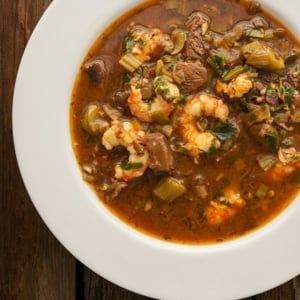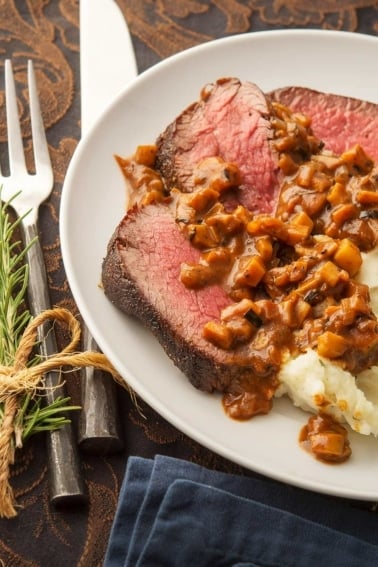As an Amazon Associate I earn from qualifying purchases.

Okra gumbo. Sounds redundant, eh? Doesn’t all gumbo need okra?
Well, no, actually. Gumbo needs at least one of the three standard thickeners: a roux; filé, which is powdered sassafras leaves; and/or yes, okra. This Creole gumbo is a fascinating, wonderful example of a lighter gumbo with no roux.
No roux, huh? I’ve made lots of gumbo in my life, and I eat it whenever I’m in Louisiana, which isn’t often enough unfortunately. Here on Hunter Angler Gardener Cook I have recipes for seafood gumbo, turkey gumbo, and even a venison gumbo. All have a roux as their base.
This Creole gumbo does not. I knew such a thing existed, and I’d even eaten it once at a friend’s home in New Orleans. So when I bought a copy of Toni Tipton’s amazing cookbook Jubilee: Recipes from Two Centuries of African American Cooking, I knew I had to play with her version of okra gumbo.
If you are unfamiliar with the difference between Creole and Cajun cooking, the shorthand is this: Creole is largely black, uses tomatoes and lots of okra. Cajun is largely white, skimps on tomatoes, and uses okra more sparingly. Keep in mind these are only general rules, not absolutes.
Tipton’s okra gumbo hinges on beef short ribs that are roasted in the oven before they go into the pot, a silky, lovely idea. I rarely cook with beef, however, so I went with a pair of deer shanks from a whitetail I’d shot in Oklahoma. Whatever you use, you want it to be full of connective tissue: Shanks, neck, shoulder.
This is an overlooked way of thickening gumbo. All that connective tissue helps thicken the broth, as does a generous use of okra, plus a dash or three of filé right at the end. No roux needed.
As a Creole gumbo, you might expect to see tomatoes here, and you’d be right. I use a just a touch of tomato in my Cajun gumbo, and people give me all kinds of grief about it. To hell with them, I say. But here, profligate use of tomato is encouraged.
Keep in mind that as with any gumbo, this one needs several hours on the stove, and is better the next day, or even the day after that. Make it on a weekend, and then your okra gumbo will keep a week in the fridge easily.
Looking for more okra recipes? I have lots. Okra stew, Lowcountry okra salad, roasted okra, pickled okra… yeah, I like okra.
Creole Okra Gumbo
Ingredients
- 2 to 4 deer shanks or other similar meat (about 3 to 4 pounds)
- 2 tablespoons vegetable oil
- Salt
- 1/2 teaspoon cayenne or red pepper flakes, (or a few dried hot peppers, broken)
- 2 bay leaves
- 2 tablespoons paprika, smoked if possible
- 12 ounces shrimp, with peels
- 2 tablespoons bacon fat, lard or vegetable oil
- 1 pound okra, sliced
- 1 yellow onion, chopped
- 2 stalks celery, chopped
- 1 green bell pepper, chopped
- 4 cloves garlic, minced
- 1 to 3 Scotch bonnet (habanero) pepper, minced (optional)
- 1 teaspoon dried thyme
- 1 1/2 cups tomato puree, fire-roasted if possible
- 1/2 pound crabmeat (optional)
- 1/2 cup chopped parsley
- Freshly ground black pepper to taste
- Gumbo file, to taste (sassafras leaf powder)
Instructions
- Preheat the oven to 400F. Coat the shanks or other meat with a thin sheen of oil, then salt well. Arrange in a roasting pan. Roast in the oven for 1 hour.
- Remove the roasting pan and add the shanks to a large soup pot. Cover with water and turn the heat to medium-high. Add some water to the roasting pan and, when it has loosened up the browned bits on the bottom of the pan, use a wooden spoon to scrape them off. Add all that to the soup pot. Stir in the cayenne, bay leaves and paprika and bring to a simmer. Add salt to taste, then cook gently for 1 hour.
- After 1 hour, add the shells from all the shrimp to the soup pot. You will likely need a total of 3 hours to render deer shanks tender, but most other meats won't take that long.
- When the shanks are reasonably tender, get a large frying pan out and heat 2 tablespoons of the bacon fat over medium-high heat. Arrange the sliced okra in the pan and sear hard without stirring for 5 minutes. Stir, then let them cook like this another 5 minutes. You want a little char and lots of browning.
- Add the chopped onion, celery and green bell pepper and keep searing on high for another 3 to 5 minutes. Now it's time to add the garlic and Scotch bonnet peppers, if you are using them. Cook all this for another 2 minutes, stirring often, then turn off the heat.
- Pull the meat off the bones of the deer shanks and shred into pieces you'd want to eat in gumbo. Strain the broth the meat cooked in. Wipe out the soup pot and return the strained broth into it, along with the shredded meat and the vegetables in the frying pan. Stir well and taste for salt.
- Add the dried thyme, the tomato puree and let this cook 20 minutes. Add the shrimp and and crabmeat, if using, and let this cook 5 minutes. Stir in the chopped parsley and lots of freshly ground black pepper. Add about a tablespoon of gumbo file if you're using it. Serve over rice or with grits.
Notes
Nutrition
Nutrition information is automatically calculated, so should only be used as an approximation.





This is a winner. I used four whitetail shanks. I got extra shanks at deer camp from a friend who was going to throw his away. Hunters really need to try cooking deer shanks whole, low and slow, like this recipe. Pitching or grinding them is missing out on superior eats.
I left out the crab because I didn’t have it on hand. Crab would be very good in this dish.
My only additions were at the end — I added about a teaspoon of Worcestershire sauce and about 1/2 teaspoon of sherry vinegar to the pot with the parsley. Both were good additions, I think.
Is this recipe a good candidate for freezing?
I substituted oxtail and I cooked it in the pressure cooker to save time. It was falling off the bone after 12 minutes.
I’m pretty new to the Cajun/creole cooking world. What’s the purpose of adding in the shrimp shells? Just flavor?
Dalton: Shells in the stock or in the finished dish? As for the finished dish, people want to see the little tail shell bit. I take them off when I’m not photographing things.
Made it tonight and it was a winner. Used quality frozen okra since it’s not in season here in Texas til later in the summer. When do you suggest the frozen okra be added?
Dee: Pretty much at the same time. Frozen okra is not cooked, only blanched, so the last 30 minutes or so.
A must try recipe now that I’m up here in the pacific northwest and not down on the gulf coast. Thanks for the share!
So much flavor. Used venison neck roasts for this crab and shrimp. It took some time but was so worth it and pretty easy. This recipe is definitely a keeper!
Another home run; we cooked this tonight and it was fantastic.
Wow this was soooooo good! I served it over a scoop of white rice – apologies if that violates any gumbo regs! This is my new favorite Hank Shaw recipe for shanks…
(but only by a slim margin over Austrian Brazed). Urge all Readers to try this – and stop putting shanks in the grind pile. There just too good for that IMO.
Hank,I normally saw my shanks down to about an inch thick, will they still work in the gumbo the same?
Donald: Absolutely. You’re cooking until the meat falls off the bone, anyway.
Mine always incorporates Andouille or venison sausage. This version looks really good.
I think the creole/ okra thing comes from west africa. They make a soup/ stew over there that’s really close to gumbo, (though it’s not called that). In it, okra is the only thickener and they don’t try to reduce the sliminess, it’s actually the point! I can’t wrap my mind around enjoying the slimy texture but many do.
Joe: It works really well, actually. The slime dissolves over time in the pot, thickening the stew without slimy ropey ick.
Hank, I have some fresh cottontail that I was thinking of subbing in for the venison, any recommendations?
Thanks
Nick: It’d work, but would be very different, making a lighter gumbo.
At least you had the sense to saute the okra to kill the sliminess.
David: That was a tip from Toni Tipton in her recipe. It’s a great trick I’ll be using from now on.
Could I use Canada Goose legs ?
Mike: Absolutely. I did it with snow goose legs the other day.
Hank, you and your readers might enjoy John Thorne’s musings on Cajun and Creole cooking that make up the second third of his Serious Pig (1996). I recently revisited it when cooking for guests and was guided by his chapter on Gombo Z’hèbes and his recipe for Chicken Jambalaya in the Crawfish Etouffée chapter. Some of my favorite writing on food.
Eric: Thanks, I’ll check that out! I’ve heard of that book but have not yet read it.
What to use if fresh okra is not available this time of year here in Sac. CA.?
Low: I used frozen okra.
it look so tasty and good.going to try it.
Did you use file in this? If so, how much? Thanks.
Mike: I add file at the table, to thicken. Just a pinch or three.